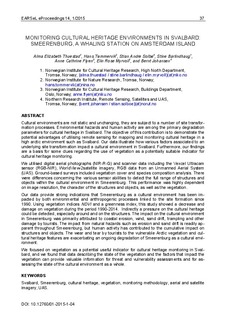| dc.contributor.author | Thuestad, Alma Elizabeth | |
| dc.contributor.author | Tømmervik, Hans | |
| dc.contributor.author | Solbø, Stian | |
| dc.contributor.author | Barlindhaug, Stine | |
| dc.contributor.author | Flyen, Anne Cathrine | |
| dc.contributor.author | Myrvoll, Elin Rose | |
| dc.contributor.author | Johansen, Bernt | |
| dc.date.accessioned | 2015-11-26T12:01:12Z | |
| dc.date.accessioned | 2015-11-30T13:41:17Z | |
| dc.date.available | 2015-11-26T12:01:12Z | |
| dc.date.available | 2015-11-30T13:41:17Z | |
| dc.date.issued | 2015 | |
| dc.identifier.citation | EARSeL eProceedings 2015, 14(1):37-50 | nb_NO |
| dc.identifier.issn | 1729-3782 | |
| dc.identifier.uri | http://hdl.handle.net/11250/2366282 | |
| dc.description.abstract | Cultural environments are not static and unchanging, they are subject to a number of site transfor-mation processes. Environmental hazards and human activity are among the primary degradation parameters for cultural heritage in Svalbard. The objective of this contribution is to demonstrate the potential advantages of utilising remote sensing for mapping and monitoring cultural heritage in a high arctic environment such as Svalbard. Our data illustrate how various factors associated to an underlying site transformation impact a cultural environment in Svalbard. Furthermore, our findings are a basis for some clues regarding the use of vegetation as a potentially suitable indicator for cultural heritage monitoring.
We utilised digital aerial photographs (NIR-R-G) and scanner data including the Vexcel Ultracam sensor (RGB-NIR), WorldView-2satellite imagery, RGB data from an Unmanned Aerial System (UAS). Ground-based surveys included vegetation cover and species composition analysis. There were differences concerning the various sensor abilities to detect the full range of structures and objects within the cultural environment in Smeerenburg. This performance was highly dependent on image resolution, the character of the structures and objects, as well as the vegetation.
Our data provide strong indications that Smeerenburg as a cultural environment has been im-pacted by both environmental and anthropogenic processes linked to the site formation since 1990. Using vegetation indices NDVI and a greenness index, this study showed a decrease and damage on vegetation during the period 1990-2014. Indirectly a pressure on the cultural heritage could be detected, especially around and on the structures. The impact on the cultural environment in Smeerenburg was primarily attributed to coastal erosion, wind, sand drift, trampling and other damage by tourists. The impact from natural hazards such as erosion and sand drift is readily ap-parent throughout Smeerenburg, but human activity has contributed to the cumulative impact on structures and objects. The wear and tear by tourists to the vulnerable Arctic vegetation and cul-tural heritage features are exacerbating an ongoing degradation of Smeerenburg as a cultural envi-ronment.
We focused on vegetation as a potential useful indicator for cultural heritage monitoring in Sval-bard, and we found that data describing the state of the vegetation and the factors that impact the vegetation can provide valuable information for threat and vulnerability assessments and for as-sessing the state of the cultural environment as a whole. | nb_NO |
| dc.language.iso | eng | nb_NO |
| dc.rights | Navngivelse-Ikkekommersiell-DelPåSammeVilkår 3.0 Norge | * |
| dc.rights.uri | http://creativecommons.org/licenses/by-nc-sa/3.0/no/ | * |
| dc.subject | Svalbard | nb_NO |
| dc.subject | Smeerenburg | nb_NO |
| dc.subject | cultural heritage | nb_NO |
| dc.subject | vegetation | nb_NO |
| dc.subject | monitoring methodology | nb_NO |
| dc.subject | aerial and satellite imagery | nb_NO |
| dc.subject | UAS | nb_NO |
| dc.title | Monitoring cultural heritage environments in Svalbard – Smeerenburg, a whaling station on Amsterdam Island | nb_NO |
| dc.type | Peer reviewed | nb_NO |
| dc.type | Journal article | |
| dc.date.updated | 2015-11-26T12:01:12Z | |
| dc.subject.nsi | VDP::Humanities: 000::Cultural science: 060 | nb_NO |
| dc.source.pagenumber | 37-50 | nb_NO |
| dc.source.volume | 14 | nb_NO |
| dc.source.journal | EARSeL eProceedings | nb_NO |
| dc.source.issue | 1 | nb_NO |
| dc.identifier.doi | 10.12760/01-2015-1-04 | |
| dc.identifier.cristin | 1293133 | |
| dc.relation.project | Norges Forskningsråd: 226413 | nb_NO |

